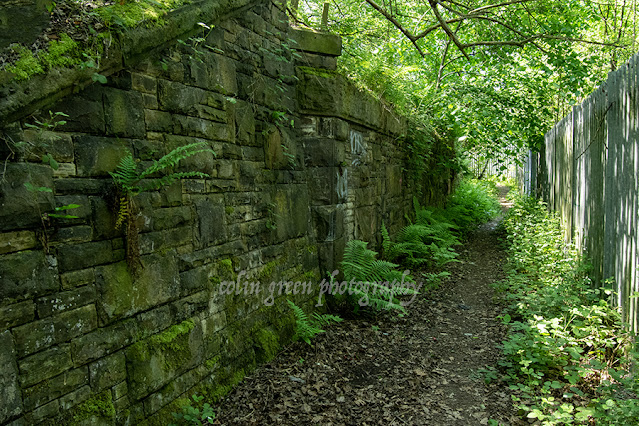The Spen Valley Greenway is a cycle-pedestrian corridor connecting Low Moor with Ravensthorpe, West Yorkshire, passing through the towns of Cleckheaton, Heckmondwike and Liversedge on route. The route runs for approx. 8 miles along the former routes of the Spen Valley Railway and Ravensthorpe Branch Lines.
The Greenway was planned after Sustrans acquired the trackbed in 1998, and opened in 2000. In addition to the remaining bridges, occasional railway signposts and ornamental benches along the route, there are artworks including Sally Matthews flock of Swaledale sheep and Trudi Entwistle's Rotate. The route is traffic free and pretty flat along it's length, with a few small gentle slopes up and down. There are supermarkets along the route including a Tesco alongside the former site of Cleckheaton Station and a Morrison's a short walk from the site of what was Heckmondwike Station.
Before conversion from an overgrown and abandoned former railway to a pleasant tarmacked cycle and pedestrian route, the greenway had a life as a railway known as the Mirfield and Low Moor Railway. The original double track line opening was in 2 stages, from Low Moor to Mirfield on the 18th July 1848, and the Ravensthorpe Branch connecting Thornhill with Heckmondwike on the 1st June 1849. At it's height the line had 8 stations along it's route which included Low Moor, Cleckheaton Central, Liversedge Central, Heckmondwike Central after which the line split with stops at Northorpe North Road and Mirfield along the Mirfield route, and Ravensthorpe Lower and Thornhill along the Ravensthorpe Branch Line. The line remained in use until passenger services were withdrawn in July 1965 and goods traffic ended in the late 1980's.
There are currently small campaigns trying to get the line reopened, as much of the trackbed remains clear and unbuilt upon this seems an easy but perhaps expensive plan. There is currently a population of over 50000 along the Spen Valley Route with limited access to rail without commuting. There are competing plans featuring heavy rail and light rail proposals.
I have previously posted the pictures taken on the route from Low Moor to the M62, the following set were taken from the M62 to the former site of Cleckheaton Central Station, they were pictured with a Nikon d3300 on the 30th December 2019.
The M62 Chain Bar Railway Bridge, pictured from the north (Low Moor) side. The line closed here whilst the M62 was constructed, this stretch of track remained open until 1981 as far south as Heckmondwike.
The southern end of the M62 Chain Bar Bridge. Laithe Hill Footbridge can be seen a sort distance down the cutting.
Laithe Hill Bridge.
Whitechapel Road Bridge,
A row of railway sleepers to the north of Cleckheaton, i'm guessing these were placed here as a nod to the greenways railway heritage.
The Spen Valley Greenway on a slight climb up to Whitcliffe Road Bridge. The line started to pen up just beyond the bridge to enter Cleckheaton Central Station and goods yard.
Whitcliffe Road Bridge from the opposite side.
The former trackbed away from Whitcliffe Road Bridge in the direction Cleckheaton Central Station.
The previous 2 pictures show the site of Cleckheaton Central Railway Station, the goods yard was off to the right of the picture and is now a Tesco Supermarket.
Cleckheaton Central was opened in 1847, and remained open to passenger traffic until June 1965, with goods traffic continued until May 1969. The station was demolished in stages between 1968 and 1971 where they story of Cleckheaton Central takes an unexpected turn.
In 1972 a contractor appeared before Wakefield Crown Court accused of stealing stone, timber, metal and other fittings from Cleckheaton Central, or as was widely reported at the time he was claimed to have stolen Cleckheaton Central Railway Station. In August 1971 British Rail's appointed contractor when arriving to clear the site found that it had already been removed. The accused had been contracted by another party to clear the site which had taken him 3 weeks to do. Despite efforts the other party was never traced and the defendant was found not guilty having proved he had been duped and left significantly out of pocket by the incident. To date this remains the only time a "Railway Station has been stolen" in the United Kingdom.
Clicking any image should open a link in another window to a un-watermarked, higher resolution version of the image on Clickasnap.
Thanks for looking, please take a moment to share and follow me on social media.
All the images remain the copyright of Colin Green.























































